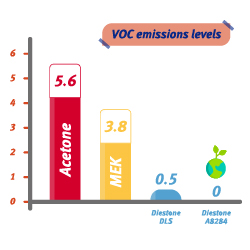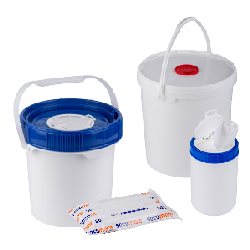VOC emission regulations run counter to the production needs of any expanding aerospace business as long as that business is using traditional industrial products.
However, technological advancements in the chemical industry have led to the emergence of a number of low-VOC and VOC-free industrial products. In addition, innovative application methods allow companies to further reduce VOC emissions.
In general terms, there are two main ways to reduce VOCs:
- using products that have low or effectively no VOC content
- storing, applying, and disposing of products in a way that limits VOCs.
Low and non-VOC products
There are three main product types that allow you to reduce or eliminate VOC emissions:
- lower VOC products
- non-VOC solvents
- water-based VOC-free products
a. Lower VOC products
Products that emit VOCs at lower rates fall into two general categories:
- 100% VOC products with low volatility
- products that have a lower VOC rate to begin with.


The more volatile a product is, the higher its evaporation rate during application and the more VOCs it releases into the atmosphere. So by reducing evaporation rates we can effectively limit VOC emissions. For example, the evaporation rate of DIESTONE DLS cleaning solvent is 7 times lower than traditional MEK solvents.
Products with lower rates of VOC are generally made from combining 100% VOC solvents with non-VOC solvents.
b. Non-VOC solvents
Certain solvents produce zero VOC emissions during application. As a result, they are not subject to European VOC regulations because they produce zero VOC emissions. Using solvents with a 0% VOC rate allows companies to eliminate VOC emissions for the particular process.
c. Water-based VOC-free products
Other cleaners are water-based and thus 100% VOC free because they don’t contain any solvent in their formula. So using these cleaners is another viable way to reduce emission.


2. Best practices to reduce VOC emissions
No matter what products you use, another way to limit VOC emissions is to forgo traditional application methods such as bulk liquids or plunger cans, which generally involve pouring an indeterminate amount of the liquid onto a dry cloth. Instead use pre-saturated wipes which allow precise control over how much product is used during the application.
SOCOMORE supplies a full range of heavy-duty wipes that come pre-saturated with solvent and water-based solutions. It helps companies to standardize surface cleaning operations, reducing their VOC emissions.
In addition, bulk products can be stored in ways that limit VOC emissions. Traditional packaging allows VOCs to leak into the air, so opt for smaller containers like small cans and wash bottles.
Regardless of the application method and whether using low or non-VOC products, companies should also review their disposal methods. This review is a complicated but important process. It requires a lot of time and effort dedicated to a careful examination of treatment and disposal operations at your facilities. However, it can have a big impact on the overall VOC emissions.
Current best practices in treatment and disposal of VOC products include
- reuse in the form of absorption, adsorption, condensation, and even membrane separation
- disposal, which can include biological processing, thermal oxidation, and catalytic oxidation.
There are also a number of innovative new treatment processes in development, including combined processes (thermal and catalytic oxidation, for example), photocatalysis, and non-thermal plasma.
VOC emissions are a problem for any company with a major industrial practice. Balancing regulations and workplace safety with growth and productivity can be a real challenge. But using any of these low-VOC and VOC-free products and processes will help you reduce emissions while staying competitive in a growing market.
